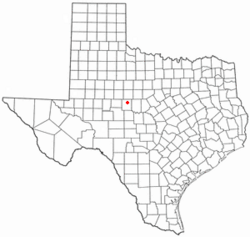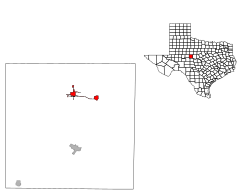Winters, Texas facts for kids
Quick facts for kids
Winters, Texas
|
|
|---|---|
 |
|

Location of Winters, Texas
|
|
 |
|
| Country | United States |
| State | Texas |
| County | Runnels |
| Area | |
| • Total | 2.94 sq mi (7.62 km2) |
| • Land | 2.36 sq mi (6.10 km2) |
| • Water | 0.59 sq mi (1.52 km2) |
| Elevation | 1,847 ft (563 m) |
| Population
(2020)
|
|
| • Total | 2,345 |
| • Density | 797.6/sq mi (307.74/km2) |
| Time zone | UTC-6 (Central (CST)) |
| • Summer (DST) | UTC-5 (CDT) |
| ZIP code |
79567
|
| Area code(s) | 325 |
| FIPS code | 48-79876 |
| GNIS feature ID | 2412289 |
Winters is a city located in Runnels County, Texas, in the United States. In 2020, about 2,345 people lived there. It's a small city that plays an important role as a center for farming and ranching in its area.
Contents
Exploring Winters: Location and Climate
Winters is found in north-central Runnels County. It's about 41 miles south of Abilene and 52 miles northeast of San Angelo. The city sits where U.S. Highway 83 meets Farm Roads 53 and 1770.
How Big is Winters?
The city covers a total area of about 2.9 square miles (7.6 square kilometers). Most of this area is land, about 2.36 square miles (6.1 square kilometers). The rest, about 0.59 square miles (1.5 square kilometers), is covered by water.
Winters' Weather: A Humid Subtropical Climate
Winters has a climate known as a humid subtropical climate. This means the summers are usually hot and humid. The winters are generally mild, meaning not too cold, but can be cool.
A Look Back: The History of Winters
The story of Winters began in 1880. Two families, C.N. Curry and C.E. Bell, settled in a place called Bluff Creek Valley. This area was southwest of where the city is today.
How Winters Got Its Name
A local cowboy named Jack Mackey suggested naming the community after John N. Winters. He was a rancher and a land agent. In 1891, a post office opened in the new settlement. Soon after, Mr. Winters gave land for a school. By 1892, about 163 people lived in Winters.
Growth and Development in Winters
Winters became well-known for its traveling brass band, started by Charles Tipton Grant in 1901. A local newspaper began publishing in 1903. The city officially became a town in 1909. That same year, the Abilene and Southern Railway built a train line from Abilene to Winters. This made land in the city much more valuable.
The first big industry in Winters was a cottonseed mill, which opened in 1909. It processed cottonseed and operated until 1939. By 1910, the population of Winters had grown to 1,247 people. A public library was built in 1964.
Population Changes Over Time
By 1980, Winters had 3,061 residents. This number dropped a bit to 2,905 in 1990 and 2,880 in 2000. However, the number of businesses in Winters increased. In 1970, there were 96 businesses, and by 2000, there were 140. Today, Winters is an important center for trade and distribution for the farms and ranches nearby.
People of Winters: Demographics
| Historical population | |||
|---|---|---|---|
| Census | Pop. | %± | |
| 1910 | 1,347 | — | |
| 1920 | 1,509 | 12.0% | |
| 1930 | 2,423 | 60.6% | |
| 1940 | 2,335 | −3.6% | |
| 1950 | 2,676 | 14.6% | |
| 1960 | 3,266 | 22.0% | |
| 1970 | 2,907 | −11.0% | |
| 1980 | 3,061 | 5.3% | |
| 1990 | 2,905 | −5.1% | |
| 2000 | 2,880 | −0.9% | |
| 2010 | 2,562 | −11.0% | |
| 2020 | 2,345 | −8.5% | |
| U.S. Decennial Census | |||
Winters' Population in 2020
| Race | Number | Percentage |
|---|---|---|
| White (NH) | 1,134 | 48.36% |
| Black or African American (NH) | 41 | 1.75% |
| Native American or Alaska Native (NH) | 7 | 0.3% |
| Asian (NH) | 3 | 0.13% |
| Pacific Islander (NH) | 1 | 0.04% |
| Some Other Race (NH) | 2 | 0.09% |
| Mixed/Multi-Racial (NH) | 63 | 2.69% |
| Hispanic or Latino | 1,094 | 46.65% |
| Total | 2,345 |
In 2020, the 2020 United States census counted 2,345 people living in Winters. There were 854 households and 610 families. The population includes people from various backgrounds, with a mix of White and Hispanic or Latino residents making up the largest groups.
Fun Things to Do: Attractions in Winters
Winters offers a few interesting places to visit.
- The Z.I. Hale Museum is a great spot to learn about local history. It's located in what used to be a clinic. The museum has old photographs and documents. Outside, you can see a Missouri-Pacific caboose, which is the last car on a freight train.
- W. Lee Colburn Park is about 7 miles east of Winters. It's right next to Elm Creek Reservoir. This park has different facilities for recreation. It also offers 14 spots for RVs (recreational vehicles) with full hookups, making it a good place for camping.
- Every year, Winters hosts a special event called "Dovefest". This festival happens on the first Saturday of September. It celebrates the start of dove hunting season. People come from all over to hunt, enjoy live music, and visit a gun show.
Learning in Winters: Education
Public education in Winters is provided by the Winters Independent School District. The district has three different schools:
- Winters Elementary School serves students from Pre-Kindergarten to 5th grade.
- Winters Junior High School is for students in grades 6 through 8.
- Winters High School teaches students from 9th to 12th grade.
Famous Faces: Notable People from Winters
Several well-known individuals have connections to Winters:
- Geoff Connor, who served as the 104th Texas Secretary of State, was born and grew up in Winters.
- Rogers Hornsby, a famous player in Major League Baseball, was born in Winters on April 27, 1896.
- Del Shores, a talented film director and producer, was also born in Winters.
See also
 In Spanish: Winters (Texas) para niños
In Spanish: Winters (Texas) para niños

